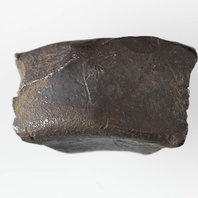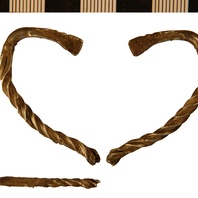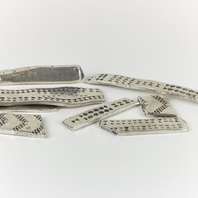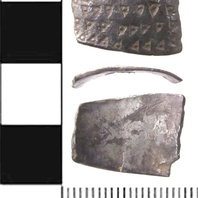
Viking Objects
Arm Ring Hacksilver (CM_1826_2001)
This piece of hacksilver was cut from a square section of a Scandinavian arm ring probably to pay for goods. The Vikings arriving in England had a bullion economy where they paid for goods with silver that was weighed to an amount agreed between the buyer and the seller. Hacksilver and silver ingots are the most common evidence for their bullion economy. It took some time for the Scandinavian settlers to adopt a monetary economy like that of the Anglo-Saxons, and both systems were used simultaneously for a while before they fully adopted the new system. They were familiar with monetary economies but they treated coins as just another form of silver before adoption of a monetary economy.
Read More

Viking Objects
Silver Arm-Ring (NLM-1B89B2)
This arm-ring fragment is made from strands of wire wound together into a single twisted or cabled strand with a cast zoomorphic terminal. This object was considered together with a group of fragments of ingots and hack-silver of probably contemporary date which were found nearby (NLM-1B0476). However, the mass of this object did not correspond closely to any of the systems of measurement thought to have been used for bullion transactions at that time. The Vikings arriving in England had a bullion economy where they paid for goods with silver that was weighed to an amount agreed between the buyer and the seller. Hacksilver and silver ingots are the most common evidence for their bullion economy. It took some time for the Scandinavian settlers to adopt a monetary economy like that of the Anglo-Saxons, and both systems were used simultaneously for a while before they fully adopted the new system. They were familiar with monetary economies but they treated coins as just another form of silver before adoption of a monetary economy
Read More

Viking Objects
Reproduction Hacksilver
These white metal reproductions of Viking Age hacksilver are typical of hacksilver finds. The Scandinavians had a bullion economy in the Viking Age and paid for goods by weight of silver rather than by using coins with a set monetary value. Arm rings are one example of wearable wealth that could be cut up to pay for goods when needed.
Read More

Viking Objects
Silver Arm Ring Fragment (SWYOR-58AFB4)
A fragment of an Early Medieval silver decorated arm ring with triangular punches each with a pellet in the centre. The object may represent hacksilver, but as it is broken rather than cut, this is not certain. Nonetheless, arm rings functioned as both a means of storing wealth as well as putting the wealth and status of the individual on display.
